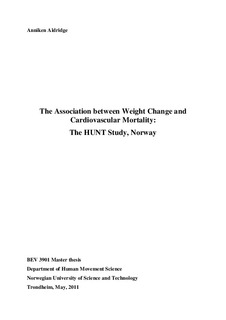| dc.description.abstract | Background: Obesity has become a widespread health problem all over the world and is related to adverse levels of cardiovascular risk factors, which rapidly improve after weight loss. However, observational studies have shown that weight gain could both reduce and increase the risk of cardiovascular diseases (CVDs), whereas weight loss have been associated with higher CVD mortality in some studies. The purpose of this study was to examine the association between changes in body weight and the subsequent risk of cardiovascular death in Norwegian adults. We also assessed if the potentially increased risk was modified by physical activity.
Methods: Weight and height were measured among 18 798 males and 22 602 females aged ≥20 years who participated in two population based studies in the county of Nord-Trøndelag, Norway, first in 1984-86 (HUNT 1) and then in 1995-97 (HUNT 2). The participants completed a detailed questionnaire including physical activity, case history, smoking, education, and alcohol consumption, and based on standardized measures of body weight and height, we calculated change in weight and body mass index (BMI) between the two surveys. We utilized a linkage to the Cause of Death Registry at Statistics Norway, with follow-up from participation in HUNT 2 until 31st December 2008. Cox regression analyses were used to calculate mortality rate ratios in different groups of weight and BMI change, and to control for potentially confounding factors.
Results: People who lost most weight had the significantly highest risk of CVD death, even when we adjusted for several potential confounders (men: RR = 1.8, 95% CI: 1.3-2.4 and women: RR = 2.2, 95% CI: 1.7-2.9). Those who gained weight between the surveys had approximately similar risk as those who were weight stable. The same tendencies were shown in analysis of change in BMI categories, but these analysis also showed a higher risk associated with being obese at both surveys (1.3, 95% CI: 1.2-1.5) compared to being normal weight.
Conclusion: In this population-based study of Norwegian adults, we found that weight loss and stable obesity was associated with higher CVD mortality, even when physical activity was taken into account, though it is possible that the follow-up period was too short to exert an effect of weight gain. Although underlying diseases are likely to be our most plausible explanation, we may cautiously suggest that to prevent health consequences caused by overweight or weight changes, people should make early establishments of normal body weight and good habits, and prevent further weight changes. | nb_NO |
